Canada Goose Export Plan to China
Info: 7992 words (32 pages) Dissertation
Published: 5th Oct 2021
Table of Contents
6. REGULATORY & LOGISTICAL ISSUES
INTRODUCTION
Canada Goose: Business history
Founded in the 1950s in Toronto by Sam Tick under the original name of Metro Sportswear LTD, the company started manufacturing wool garments and raincoats which were sold only locally. It was not until the 1970s when the company began to produce garments with bird feathers in them, most commonly known today as “down fill insulation”. During that time, the label Snow Goose was created, which was later changed to Canada Goose (Wikipedia, 2018). Since then, the company has seen continued growth and part of that is due to the icon it became. Preferred by mountain climbers, arctic adventurers and film crews that shoot in cold locations, the brand received a lot of exposure and recognition, strengthening its brand identity (Wikipedia, 2018). Furthermore, pursuing the idea of 100% of garments “Made in Canada”, around 2010 Canada Goose acquires a manufacturing facility based in Winnipeg in order to meet the increasing demand. As of 2014, Canada Goose was employing 6% of the cut & sew labor industry in Canada and had great contribution to the country’s economy (Canada Goose, 2018). In March 16, 2017, the company went public and made its IPO in the New York Stock Exchange (NYSE) and the Toronto Stock Exchange (TSX), raising CAD 340 million (~US$ 255 million). Until today, this now corporation with headquarters in Toronto has been innovating and broadening the range of products and garments, being knitwear as the latest introduction to the brand’s portfolio (Canada Goose, 2018).
Organizational goals and objectives
As mentioned above, Canada Goose is committed to the idea of having all of their garments manufactured in Canada. In their belief, cold weather is part of Canadian culture and there is no one better at knowing what to produce and how to produce it in order to insulate our bodies from the extreme cold temperatures.
In addition, the company is pursuing growth strategies that can be divided in four categories (Canada Goose, 2018):
- Advance market development: Linked to strengthening the company’s brand, enhancing wholesale network and developing the e-commerce market.
- Pursue global growth: With opportunities to develop further the Canadian and the US (mainly Pacific Northwest), the company’s strategy is to enter or dive deeper into the European (especially Eastern Europe) and Asian markets. As a reference, market penetration for their jackets reached 52.2% in Canada, but only 10.2%, 6%, 5% and 1.4% in Japan and South Korea, United States, Western Europe and China, respectively.
- Enhance product offering: its product portfolio has been growing and will continue to grow. From producing only outerwear for heavy winter conditions, Canada Goose is now offering options for fall and spring, as well as accessories (gloves, hats, etc.) and knitwear.
- Drive higher margins: The strategy here is to expand the DTC channel, optimize and gradually increase prices and improve manufacturing techniques to achieve maximum efficiencies.
Purpose of the Export Plan
When markets are developed, and market penetration is extremely hard to achieve, companies have two ways of growing: taking market share from its competitors or find new foreign markets. The first one is harder to achieve, since most brands are well positioned and will do anything to keep their customers. The second one, however, represents great opportunities but at the same time, great challenges as well. As the outdoor industry and markets mature in Canada and competition is fierce, China represents new opportunities for foreign brands. Canada Goose has been around for many years in Canada and has been established as a strong brand. But also have other local and foreign competitors, like The North Face, Ralph Lauren and Lululemon Athletica, among others (Marketline Advantage, 2017). In this sense, Canada Goose needs to find growth internationally.
Even though the outdoor gear market has slowed down its growth in China it is still expected to see single digit growth over the next 5 years (NBC Right now, 2018). However, Canada Goose has another advantage: it is not only an outdoor gear brand, it has also become a fashion brand, so growth and expansion opportunities are even greater. China is the biggest luxury market and Canada Goose can be positioned as a luxury and an outdoor brand, competing within both industries.
Short and medium-term objectives for exporting
In the short-term, the objective is to promote the brand and get Chinese consumers to about the Canada Goose brand. This will require great marketing efforts and a lot of financial investment, but we believe that both of these are mandatory in a market as big as China.
In the medium to long-term, the objective is to position the brand as the most luxurious outdoor brand, which can be worn either in the city or in the wild. In order to do so, we must build a distribution network, with brick and mortar stores in luxurious malls but also through e-commerce. As a matter of fact, Canada Goose has already been negotiating with the Asian giant Alibaba, which is expected to greatly boost sales once the high-quality clothing brand starts selling through the web in Asia (The Canadian Press, 2018).
ORGANIZATION
Ownership
For the majority of time since its birth it has been a family-owned business. Sam Tick passed down the ownership to his son-in-law David Reiss. This marked a new era with the launch of volume-based filling machine and change of label name to Snow Goose. But, the person to raise the company to its current stature and make renowned brand was Dani Reiss, son of David Reiss, who joined the company in 1997 and became the CEO in 2001. Dani brought with him the pledge to remain “Made in Canada” as company corporate strategy. On Dec 10, 2013 Canada Goose sold majority of its share to American investment firm Bain Capital. This was the time when the company passed its family legacy by making every family member except Dani Reiss sell their shares. Dani continued to have significant minority shares and holding the position of CEO in the company.
Canada Goose went public in March 2017 in stock markets in Toronto and New York. Majority of the company’s share were still hold be Bain Capital (TheMorningStar, 2018).
Management
Canada Goose is managed by a team of experienced professionals who govern the business in America, Europe and Greater China (See appendix 1). (Canada Goose, 2018)
Scott Cameron leads the cross-functional operations in Greater China. He joined company in 2016, previously serving as Executive Vice President of E-Commerce stores and strategy. He holds the responsibility for market development and managing the regional office in Shanghai.
Staffing
Canada Goose employs 3000 workers worldwide. It employs 20 percent of cut and sew labour industry in Canada. It has facilities in Toronto, Quebec and Winnipeg, with the Winnipeg capacity being the larger employing 700 people.
Level of commitment by Senior Management
Dani Reiss, the CEO of Canada Goose, believes that Made in Canada is extremely important for the company and they choose their partners who believe the same. Although the company has plans to make expansion plans but there are no plans to move production unit out of Canada. (Financial Post, 2013). Another interesting thing to focus upon while observing the level of commitment by management is regarding use of coyote fur. Canada Goose has received protests around the globe from animal welfare organizations like PETA etc. to raise voice against use of coyote fur for making jackets and parkas. The management team however shows strong commitment by vowing to use animal fur calling the Canada Goose as ‘functional-first brand’ (Macleans, 2017).
Corporate experience and expertise in exporting
Canada Goose holds expertise in export operations by providing their customers premium quality goods in 38 countries. Canada Goose ships their products to the Brick and Mortar stores in USA, London and China but it also provides D2C (direct-to-consumer) service which contributes to a major proportion of their revenue. Canada Goose was named as Ontario Exporter of the year in 2016 at Toronto gala for international exports. (Ontario Export Awards, 2016)
Strategic alliances
Canada goose has made strategic alliances with Alibaba group and Tmall for its operations in China. It has partnered with Toronto based firm ImagineX for retail management and to help with operations including staffing and daily administration.
Labor market issues
In the annual management report (Forrest, 2017), Canada Goose highlighted its concerned with labour related matters. There is an increasing trend in the labour force employed to join unions in future. This exposes them to increased risk of strikes and other labour disputes. Any of these disputes, particularly in the independent factories creates risk of production slowdown. Moreover, labour disputes in transportation carriers and shipping ports create risk of slow shipping during peak manufacturing and can result in financial and reputational loss.
PRODUCT
Description of products
Canada Goose ranges a wider variety of products from jackets, parkas, vests, gloves, hats, shells and other apparels. But its primary signature product has been parka which is used by Polar Explorer such as Ben Saunders. With all their products being made in Canada, Canada Goose tries to bring a sense of pride in its Canadian consumers. It bolsters the Canadian craftsmanship and its attention to details. And with use of online service, it provides direct-to-consumer service along with the perks of free shipping around the globe. Using skilled Canadian craftsmanship and sewn by patented knitting machine, Canada Goose provides a premium level quality of products. It also provides the one of a kind coats made of up Coyote fur.
Manufacturing of products
Canada Goose currently manufactures its clothing in 7 facilities, all located in Canada: 3 in Manitoba, 3 in Ontario and 1 in Quebec. This newly inaugurated Winnipeg facility will help satisfy the demand of its continuous global expansion. Currently, the company has almost 3,000 employees and is responsible for the employment of the 20 percent cut & sew labor in Canada. Canada Goose is convinced that part of the success of the brand is owed to not only its slogan but also its core: 100% Made in Canada. The company relies on Canadian quality of labor and materials and we cannot deny that it has been a very successful story so far. However, this is an important aspect to keep in mind when expanding globally. At some point in time, as foreign markets keep growing, companies feel the necessity to open production facilities at those foreign countries to reduce costs and remain competitive. Since Canada Goose will not pursue this strategy, it is important to develop an expertise in exports to keep those costs at its minimum.
Comparative advantage in production and future products
Canada Goose’s CPO Lee Turlington claims that the brand’s success and comparative advantage relies on the fact that their products look good and actually work. When compared to other brands which produce a wide range of products with different qualities, Canada Goose’s products are all high-end top quality. This sets them apart from the rest and the company has gained its reputation from it. Another comparative and competitive advantage of the company is the supply of down and fur, and its commitment to responsible farming and sustainability. Through its recently implemented traceability program, the company is fully committed to ensure that all the materials come from responsible and ethic sources, where animals, people and the environment are treated well. The company purchases 100% of the down from Feather Industries Canada Ltd. The company has leveraged from these aspects and has brought its high-quality products and craftsmanship into other categories, like spring season clothing and knitwear. This will help the company reduce the effect of seasonality since previously all its products were for cold weathers and winter season.
MARKET OVERVIEW
Market Research
Canada Goose is a high cost luxury cold weather apparel, understanding the market where sales of such item will thrive is paramount to our choice of market entry. Therefore, our focus is targeting cities with a high population, disposable income as well as cold weather climate.
Using data from Euromonitor (Appendix 2), which shows the high-income households in China and the growth of disposable income, we coupled this information with cold weather climate data to narrow down the possible expansion cities down to Shanghai, Wuhan and Shenyang. Shanghai has a population of 24million people, Wuhan-10.5 million and China as a whole represents a population of 1.4 billion people which creates a sizeable target market.
Political Environment
The communist party of China is the founding and ruling political party in China. According to the CIA factbooks, China enjoys a stable political environment albeit a lack of openness and transparency. However, despite this lack of transparency, the stable political environment, cheap labour and improved infrastructure make China an attractive destination for foreign trade and investments.
Economic Environment
According to research done by the EDC (Export Development of Canada), China ranks as one of the largest economies and a top export destination for Canada. China also possesses a large domestic market with a globally integrated supply chain that continues to attract foreign investors. With the continued rise in production costs, the Chinese government is moving the economy towards increased reliance on service-oriented and domestic consumption driven economy which reduces its exposure to shocks in global demand. Though the increased reliance on domestic consumption creates a risk for Canada Goose products, the country’s move towards a stronger and more stable economy provides an upside to help shield the effect of a loss of disposable income during a global economic downtown.
Size of Market
The market size of the apparel market in China has been on a continued steady growth since 2012 and currently stands around US$ 300 billion (See Appendix 3).
Key Market Segments
China’s Outdoor wear: According to research done by consulting company A.T. Kearney (2013), only about 5 percent of the population in China engage in outdoor sports. However, the popularity of the sports is steadily growing, in addition to consumers who also buy outdoor apparel for everyday use which serves their comfort and functionality needs. This increase in participation in outdoor activity translated to a doubling of the outdoor wear brands in China from 400 in 2007 to 800 in 2011.
Purchasing process and buying criteria
In 2016, 53% of Chinese households possess a smart phone and contributed to 52% of global m-commerce value sales (Appendix 4). Internet retailing became the number one distribution channel for apparel in china and this process continued to see an increased growth in 2017. This channel offers consumers hassle-free home delivery, competitive price and wide selection of product offering. Retailers alike are continuing to take advantage of this channel by launching official online retail stores or flagship stores on leading B2C (business to consumer) platforms such as Tmall.com and jd.com. With the advent of online retailing, traditional channels such as department stores are experiencing shrinking value shares, and this is forcing retailers to change strategic purposes of these stores to be more consumer centric and focused on experience.
Description of industry participants
Most of the players in the outdoor wear category have limited market shares, with five brands taking about 50% of market share in this category. International Brands such as North Face, Columbia, Jack Wolfskin and Northland have been competing on a similar price range with Chinese brand Ozark and Toread (A.T Kearney, 2013). All leading brands are continuing to expand aggressively in this sector and this represents increasing challenges for Canada Goose within this market.
Market share held by imports
In China’s apparel market, international brands continue to gain traction against local brands (Inside Retail Asia, 2017). In 2017, among the top 60 brands in China, the combined share of Chinese producers fell to 59 per cent from 64 percent in 2011. In examining the market, results from a survey carried out by OC&C found that those who favour local brands are younger and typically come from lower income brackets and choose value for money as their top reason for purchasing Chinese brands. Shoppers who opt for international brands rate quality, design and variability as their key decision factors in choosing international brands (Appendix 5).
Tariff and non-tariff barriers
According to EDC, exporters from Canada to China listed their top challenges to operating in China and this includes: conforming to local standards and regulation, language and cultural differences, building relationships and obtaining market information.
Market Outlook
According to Euromonitor, the apparel market is expected to see a steady value growth over the next forecast period with a forecasted market size of US$320 billion in 2022, an estimated 14 per cent growth over the next four years (Appendix 6). This growth will be fueled by China’s continued growth in consumer expenditure which will grow by 6.8% in 2018. Clothing and footwear will lead the way in the growing expenditure category between 2018 and 2030 (Euromonitor, 2018). Disposable income per capita which totalled US$5,398 in 2017 is set to grow by 6.7% in real terms in 2018 and an average annual rate of 5.4% between 2018 and 2030.
MARKET ENTRY STRATEGY
Target markets based on demographics in China
Based on data on high-income households in large Chinese cities from 2016 to 2021, Nanjing which is close to Beijing, Tianjin which is close to Shanghai, Wuhan, and Shenyang are cities with demographics of high-income consumers (Appendix 2). As such, we recommend that Canada Goose target these markets to build brand awareness and visibility.
Target audience: High-income Chinese men and women between ages 25 and 45 who could afford winter jackets/coats that cost at least CAD$1000. In terms of personalities, we will target customers who are creative, discerning and want a good balance between functionality and style. Many international luxury brands are thriving in Asia due to Chinese consumers’ newfound willingness to spend instead of saving. Italian coat maker Moncler, one of Canada Goose’s biggest rivals, already has a significant presence in the region, with about 40 percent of its business coming from its Asia division. Chinese consumers are becoming more amenable to legacy cold-weather brands as interest rises in winter sports and culture. Though there were only about 12.5 million skiers in China in 2015, the government has said it hopes to attract an additional 300 million non-skiers to mountain resorts and ski slopes. The 2022 Winter Olympics will be held in Beijing.
Description of key competition in China
Moncler
Moncler is an Italian apparel manufacturer and lifestyle brand founded in 1952 by René Ramillon most known for its down jackets and sportswear. Moncler took its name from the abbreviation of Monestier-de-Clermont, an Alpine town near Grenoble, France.
Gucci
Gucci is an Italian luxury brand of fashion and leather goods. Gucci was founded by Guccio Gucci in Florence in 1921.
Arc’teryx
Arc’teryx is a Canadian-based outdoor clothing and sporting goods company founded in North Vancouver, British Columbia, in 1989. The name and logo of Arc’teryx refer to the Archaeopteryx, among the earliest known birds. The logo is based on the “Berlin specimen” of the bird, the most complete skeleton found to date.
Prada
Prada S.p.A. is an Italian luxury fashion house, specializing in leather handbags, travel accessories, shoes, ready-to-wear, perfumes and other fashion accessories, founded in 1913 by Mario Prada.
North Face (part of VF corporation)
The North Face, Inc. is an American outdoor product company specializing in outerwear, fleece, coats, shirts, footwear, and equipment such as backpacks, tents, and sleeping bags.
Patagonia, based in Ventura
Patagonia, Inc., originally Chouinard Equipment, is an American clothing company that markets and sells sustainable outdoor clothing. The company was founded by Yvon Chouinard in 1973, and is based in Ventura, California.
Analysis of competitive position
According to Alice et al (2005), Chinese consumers need a product that can protect them against the harsh winter climate (Appendix 7). Hence, the apparel that Canada Goose manufactures must be high-performance with good functions to protect customers from harsh weather conditions. Their need for comfortable fabric implies that Canada goose must source for high-quality materials that are comfortable and can serve as insulation during winter too. Fashion is a lifestyle for Chinese consumers which implies that Canada goose needs to manufacture apparel that is functional, of premium quality, and trendy. We carried out a market positioning and classified brands based on average prices of men and women’s jackets/coats and how they are perceived as a brand (functional or fashionable). There is a white spot which represents an opportunity that Canada Goose can optimize to find a product differentiation in the Chinese market (Appendix 8).
Market Position
To high-income Chinese consumers, Canada Goose is the outdoor winter apparel that is a fashion statement and practical in terms of functionality because of its high-quality craftsmanship and noteworthy authentic styles. The product differentiation of Canada Goose is premium-quality winter sport outerwear with functional versatility and fashionable. Over the years, Canada Goose has successfully broadened its reach beyond Arctic heritage to outdoor enthusiasts and urban explorers. There is demand for Canada Goose to grow as a multi-season brand, so spring outerwear, layers and lighter pieces have been and continue to be a large focus. With an increase in market offering comes the threat includes counterfeit Canada Goose apparel. A breakdown of the SWOT analysis for Canada Goose in China can be found in Appendix 9.
Distribution Strategy
Canada Goose sells through wholesalers for most of its history and only started DTC strategy via e-commerce and a few flagship stores in 2017 due to growing threat from Amazon and declining mall traffic.
The direct-to-consumer category, which accounted for 29 percent of Canada Goose’s revenue in the fiscal year ended March 31, will grow faster and could one day overtake wholesale as the biggest source of sales. The recommended Long-term Action Plan for Canada goose are segregated according to different timelines- Short-term in step 1, mid-term in step 2 and long-term in Step 3.
Step 1: Agents, T-Mall (online store) to build brand awareness
Step 2: Flagship stores
Step 3: Distributors via network
Promotion Strategy
Before promoting a product, extensive market research (primary and secondary) must be done to understand Chinese’s preferences for product features and underlying needs and desires. Based on the table of survey results (Appendix 7), we recommend Canada goose adapts to preferences of Chinese consumers – Climate, fabric, fashion and comfort.
As such, some market adaptation by Canada Goose is required.A china-specific website in Chinese language must be implemented to create brand awareness among Chinese consumers who can only read Chinese language. Although apparel can be standardized because apparel catered to North America consumers are designed with premium quality and to protect consumers from harsh winter climates like those experienced in China (Appendix 10).
Channels for marketing/development of leads
There are several channels that Canada Goose can adopt to break into the China market. They are:
- Social media marketing and data analytics to increase brand visibility via popular social media in China. Social media influencers campaigns. Use of Chinese celebrities as brand ambassadors to increase brand awareness Social media contests (tag a few friends) by social influencers to increase brand awareness. Examples are WeChat – Facebook, Instagram. Can advertise in Little Red Book too. Wechat is a social media platform that works with Chinese Key opinion leaders to convert online traffic to sales.
- Flagship pop-up store events for consumers to try and test quality of Canada goose jackets in fabricated harsh winter conditions. The most distinctive advantages of flagship stores as an entry method include ensuring the greatest level of international coverage, designing a blueprint for post-internationalization expansion.
- T-mall (Online store) to sell online: The internet has become increasingly important for luxury fashion retailers, particularly in terms of omnichannel communication and omnichannel distribution strategies
- Fashion Shows – e.g. Shanghai fashion week
- In terms of marketing communications, we propose that Canada goose connect with Chinese consumers using an Emotional ignition point with story-telling. They are looking for a winter coat that connects fashion with good functionality and worn by Chinese celebrities that are known to be trendy.
REGULATORY & LOGISTICAL ISSUES
Intellectual property protection
Foreign firm’s Intellectual property rights in China is difficult to enforce due to local judicial protectionism, challenges in obtaining evidence, small damage awards, and a perceived bias against foreign firms (Weightman, 2018). However, as Chinese firms are booming globally and self- developed high-tech innovation, the demand for IP protection increases. The IP legal reform creates a friendly environment for foreign firms (Weightman, 2018).
Local Judicial Protectionism
China has taken important steps to eliminate local judicial protectionism and ensure a fair adjudication process in IP cases. This will ensure that both domestic and foreign litigants receive fair treatment.
Challenges in Obtaining Evidence
One interpretation creates a fair process for procuring information.
Small Damage Awards
These new interpretations of evidence will also help with the problem of damage awards. a general trend in increasing damage awards in IP litigation (Weightman, 2018). In fact, the average damages awarded for patent infringement by the Beijing IP Court have increased more than three-fold from 450,000 RMB ($70,000) in 2015 to 1.4 million RMB ($217,000) in 2016. Trademark infringement cases now see average damages around 1.7 million RMB ($263,500) and copyright cases see awards that average 458,000 RMB ($71,000) (Weightman, 2018).
Bias Against Foreign Firms
In terms of policy, last year, China finished a four-month nationwide campaign coordinated across 12 government agencies to protect the IP rights of foreign firms (Weightman, 2018). The hope is that the campaign will improve cooperation among IP enforcement bodies, create a sound environment for foreign investors, and deter future violations of foreign IP. While the system is far from perfect, the impact of these reforms should not be understated (Weightman, 2018). These changes represent a positive trend in China’s commercial environment and as the laws continue to nurture domestic innovation, foreign firms ignore this progress at their own risk.
Other regulatory issues
China’s commitment to trade liberalization, there are no restrictions on the import of most products.
Transportation and cargo
Modes of transportation and cargo insurance are arranged by service providers. Transportation and cargo insurance are provided by freight forwarders.
Cost: from Vancouver to Shanghai
Shipping costs a 20ft and 40ft containers from a port in Vancouver to Shanghai are approximately $842 and $1257 respectively (Appendix 11).
RISK FACTORS
Market Risk
Canada Goose already has 2 stores in Hong-Kong and Beijing. The company’s decision to export to China is as a result of an increase in demand from Chinese consumers over the years. China still has to face many challenges: an aging population and shrinking workforce, the lack of openness of its political system and issues of competitiveness in an economy dependent on high capital spending and the expansion of credit. A large gap remains between the living standard of the cities and the countryside, between urban zones on the Chinese coast and the interior and western parts of the country, as well as between the urban middle classes and those who have not been able to profit from the growth of recent decades. These inequalities are becoming increasingly worrisome for both Chinese authorities and investors. Poverty has largely decreased in China and unemployment remains stable (the rate has hit its lowest point in recent years at 3.95%). According to the Minister of Human Resources and Social Security Yin Weimin, the low unemployment rate was largely due to the new internet economy and entrepreneurship. Many analysts say, however, that the government figure is an unreliable indicator of national employment levels as it considers only employment in urban areas and also does not measure the millions of migrant workers that every year arrive in the country. Finally, around 43 million people continue to live on less than USD 1 per day, the poverty line set by the government (according to official statistics, five years ago about 100 million people lived below that line).
Some market risks may include
- strong competition from well-resourced and positioned state-owned enterprises
- finding and retaining the right skills in the local workforce
- Ageing population and shrinking workforce
- complex business culture
- language barriers
- need for patience to build up trust and networks
- significant time difference
- weather extremes across the country and high levels of pollution in certain urban centers
Political risks
- Anti-monopoly legislation used against foreign firms
- Bribery and corruption
Credit & currency risks
Canada Goose exporting into China may also be importing manufacturing components from China. If so, there could be a natural currency hedge, as some supplier invoices match a portion of sales revenue. In this case, it may be worth exploring an offshore bank account domiciled in China that can hold RMB denominated balances. Whilst such a facility may be difficult for some businesses to establish, it is becoming more realistic due to ongoing liberalization. If foreign currency receipts be large and frequent, then regardless of whether there is a natural hedge, an RMB facility for customers to pay into has some merit. Creating a market in China would enable the company to strategically price their products to improve their profitability. China’s credit level is relatively high by international levels. Corporate debt had reached 165% of their GDP at the end of 2017 and household debt though still low had risen by 15% of GDP over the past 5 years (Euromonitor). The Chinese economy is quite volatile and one of the ways Canada Goose can protect itself from the fluctuations is through currency hedging. This is the act of entering into a financial contract.
FINANCIAL PLAN
Revenue or sources of funding
One of the most advantageous ways to finance expansion is through earnings the business has created and that can be retained (Appendix 12). The only cost to using retained earnings is the interest received if you kept the earnings in a bank account or used in more production investment. Since this amount is likely to be much less than you will earn by successfully investing the funds in growing your business, plowing retained earnings back into your business is usually a smart move. One risk to financing with internally generated funds is that Canada Goose may divert too much of current profits into expanding the business. To hedge against this, the company will set a budget that will guide financial operations of this expansion.
Bank Loans and Lines of Credit
Canada Goose can also fund this expansion through bank loans or lines of credit. Some loans that the company’s operations may be open to include;
Line-of-credit loans: This is a short-term loan that extends the cash available in your business’s checking account to the upper limit of the loan contract. You pay interest on the actual amount advanced from the time it is advanced until it is paid back. Line-of-credit loans are intended for purchases of inventory like materials and payment of operating costs for working capital and business cycle needs like leasing of space for flagship stores and marketing.
Secured and unsecured loans: Loans can be secured or unsecured. An unsecured loan has no collateral pledged as a secondary payment source should there be a default on the loan. The collateral is usually related to the purpose of the loan. In the case of Canada Goose, the inventory will serve as collateral. Loans secured with receivables are often used to finance growth, with the banker lending up to 75 percent of the amount due, depending on the lender. Inventory used to secure a loan is usually valued at up to 50 percent of value of the investments.
Letter of credit for distributors: Canada Goose use this to guarantee payment from its distributors in China. The document substitutes the bank’s credit for the distributors up to a set amount for a specified period of time.
APPENDICES
APPENDIX 1
CANADA GOOSE ORGANIZATIONAL STRUCTURE
Board of Directors
President & CEO
Executive VP, CFO
Chief Commercial Officer
President, International
Senior VP, Planning & Sales Operations
Chief Marketing Officer
Chief Information Officer
Chief Product Officer
Executive VP, People & Culture
President, Greater China
Executive VP, Chief of Staff
VP Manufacturing & Supply Chain
Senior VP, Merchandising & Product Strategy
Senior VP, General Counsel


APPENDIX 2
HIGH INCOME HOUSEHOLDS IN LARGE CHINESE CITIES AND DISPOSABLE INCOME CAGR 2016-2021 (SOURCE EUROMONITOR INTERNATIONAL)
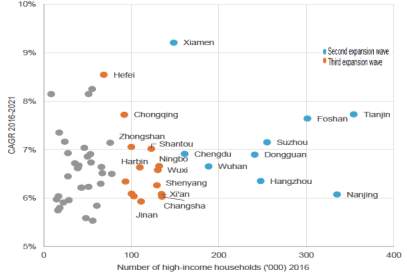
APPENDIX 3
FIGURE 2: APPAREL INDUSTRY. SOURCE EUROMONITOR
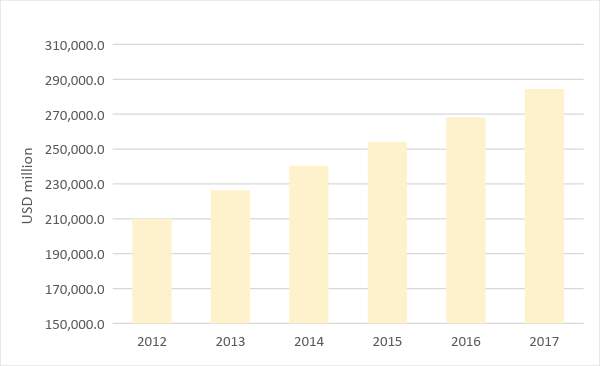
APPENDIX 4
APPAREL AND FOOTWEAR THROUGH INTERNET RETAILING: CHINA VS US VS REST OF THE WORLD 2016-2021. SOURCE: EUROMONITOR
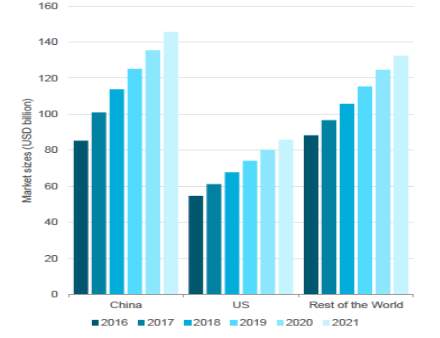
APPENDIX 5
APPAREL PLAYERS BATTLE FOR MARKET POSITION ACROSS CITIES. SOURCE: A.T KEARNEY ANALYSIS
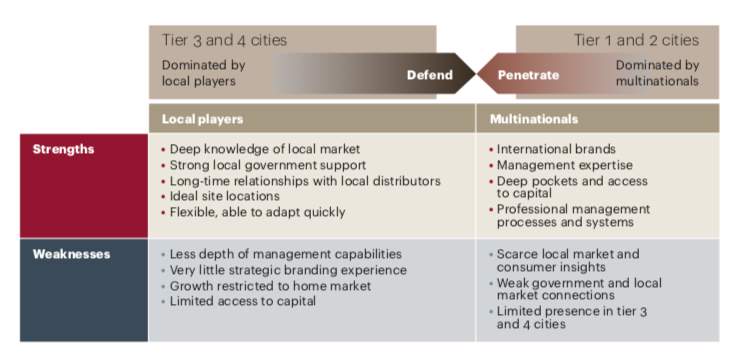
APPENDIX 6
APPAREL MARKET FORCAST
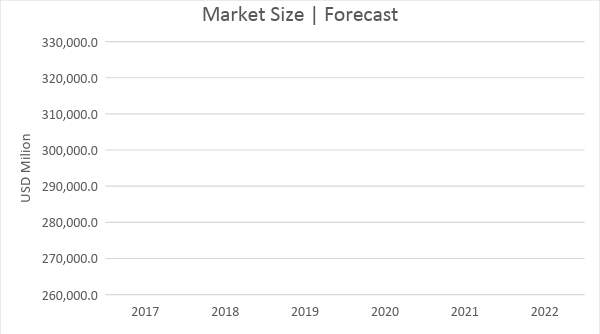
APPENDIX 7
SURVEYS DONE TO RESEARCH ON PHYSICAL, IDENTITY AND LIFESTYLE CONSUMER PREFERENCES IN CHINA (CN-2004)
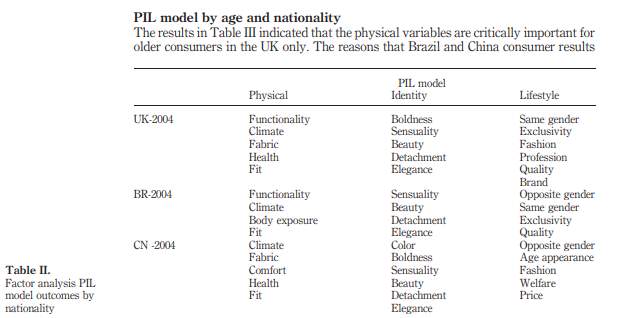
APPENDIX 8
MARKET POSITION FOR CANADA GOOSE AND COMPETITORS
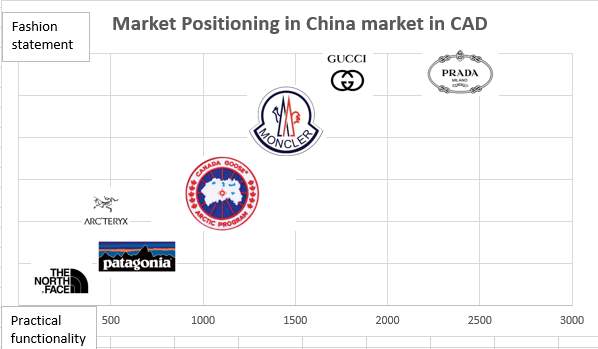
APPENDIX 9
SWOT ANALYSIS
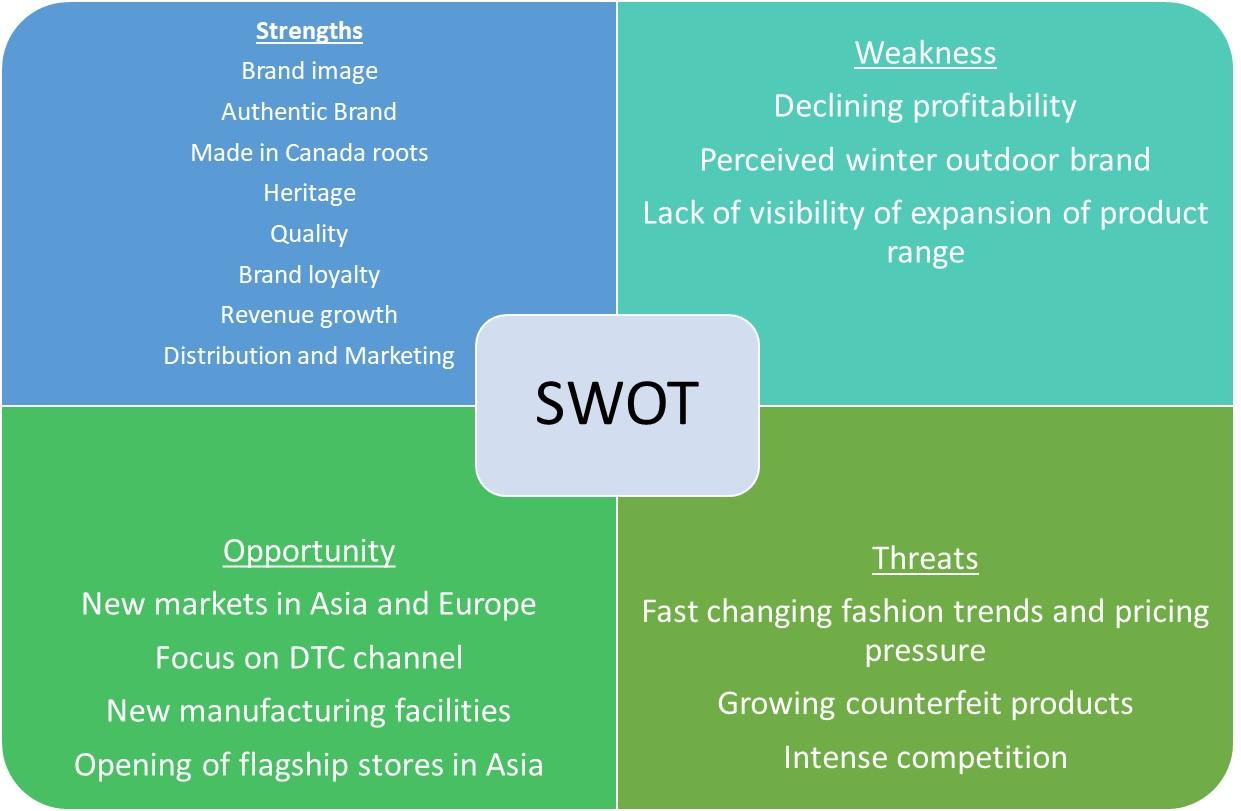
APPENDIX 10
PRODUCT/MESSAGE
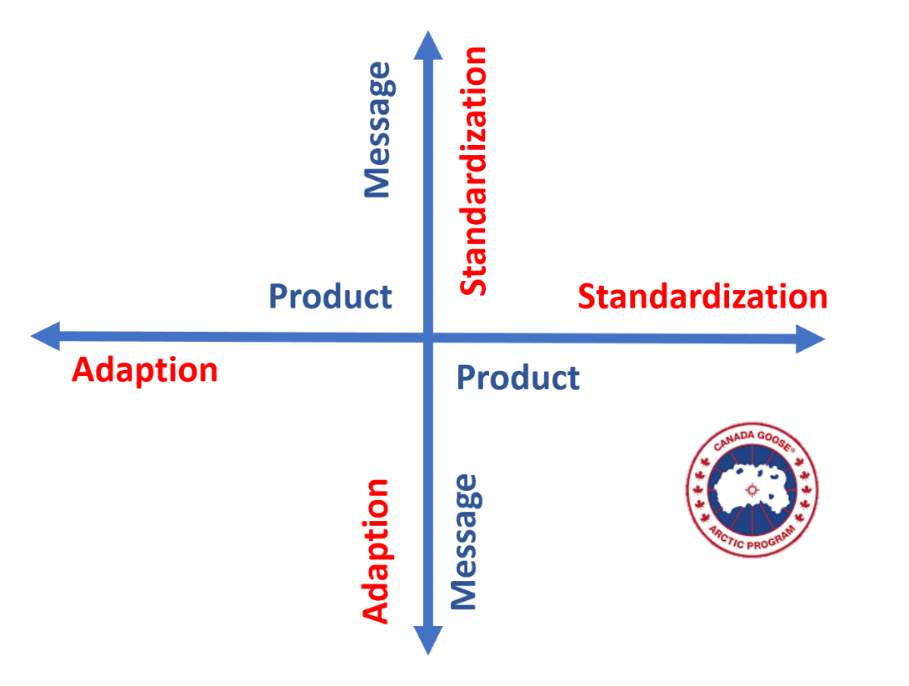
APPENDIX 11
SHIPPING COST (FROM TRADE COMMISSIONER OF CANADA SERVICE)


APPENDIX 12
FINANCIALS
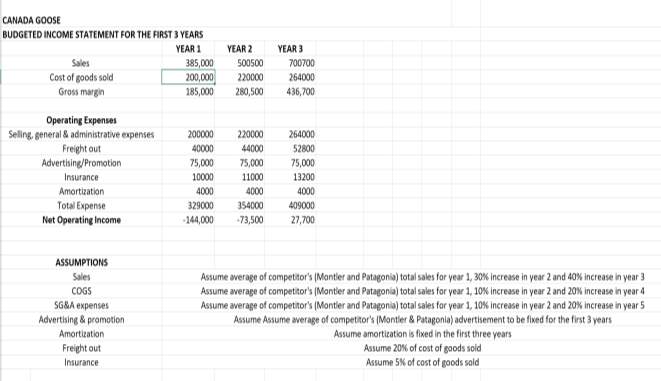
REFERENCES
2016 Winners. (n.d.). Retrieved October 3, 2018, from http://www.ontarioexportawards.com/2016-winners/
Apparel and Footwear in China- Analysis (pp. 1-5, Tech.). (2018). Euromonitor International.
Bhasin, 2018, Canada Goose Plots China Expansion, Retrieved from https://www.bloomberg.com/news/articles/2018-05-31/canada-goose-plots-china-flight-path-with-physical-online-plan
Canada Goose Inc. – Corporate Governance. (n.d.). Retrieved October 3, 2018, from https://investor.canadagoose.com/corporate-governance/default.aspx?section=management
Canada Goose. (2018). Canada Goose. Retrieved from https://www.canadagoose.com/ca/en/ourhistory.html
Canada Goose. (2018). Canada Goose. Retrieved from https://www.canadagoose.com/ca/en/fur-and-downpolicy/fur-and-down-policy.html
Canada Goose. (2018). Canada Goose Investor Relations. Retrieved from https://s21.q4cdn.com/699882010/files/doc_presentations/2018/03/Canada-Goose-InvestorHandout-v2.pdf
Country Information on China | Export Development Canada. (n.d.). Retrieved October 3, 2018, from https://www.edc.ca/en/country-info/country/china.html
DeAcetis, 2018, Canada Goose: Pioneered Outerwear Solutions With Advanced Technology, Retrieved from https://www.forbes.com/sites/josephdeacetis/2018/04/28/canada-goose-pioneered-outerwear-solutions-with-advanced-technology/#5eaf754d1861
Foreign Affairs Trade and Development Canada, International Trade, & International Business Development. (2018, August 07). Freight Forwarders, Custom Brokers and Logistics Services – Shanghai, China. Retrieved October 3, 2018, from http://tradecommissioner.gc.ca/china-chine/market-facts-faits-sur-le-marche/156722.aspx?lang=eng
Forrest, D.M. (2017). Annual Management Report 20-F. Canada Goose
Maria Alice V Rocha, Lynne Hammond, & David Hawkins. (2005). Age, gender and national factors in fashion consumption. Journal of Fashion Marketing & Management, 9(4), 380–390. Retrieved from http://ezproxy.library.ubc.ca/login?url=http://search.ebscohost.com/login.aspx?direct=true&db=bth&AN=20132800&login.asp&site=ehost-live&scope=site
GOOS Canada Goose Holdings Inc Major Shareholders | Morningstar. (n.d.). Retrieved October 3, 2018, from http://quote.morningstar.ca/Quicktakes/owners/MajorShareholders.aspx?t=GOOS®ion=CAN&culture=en-CA
Hi, S., Ling, G., & Li, J. (2013). Winning China’s Apparel Market (pp. 1-10, Rep.). Korea: A.T. Kearney.
Inside Retail Asia. (2017, August 02). Internationals dominate China’s apparel market. Retrieved October 3, 2018, from https://insideretail.asia/2017/08/02/internationals-dominate-chinas-apparel-market/
Kraugerud, P. (2017). Lululemon Athletica Inc Apparel and Footwear World (pp. 1-39, Rep.). Euromonitor.
Marketline Advantage. (2017, October 31). Marketline Advantage. Retrieved from http://0advantage.marketline.com.biblio.url.edu/Product?ptype=Companies&pid=F301EFEB-05A7-469C-BDAB-F03E120A5643
NBC Right Now. (2018, September 7). NBC Right Now. Retrieved from http://www.nbcrightnow.com/story/39044904/china-outdoor-gear-market-growth-analysis-trends-industry-size-and-future-forecasts-2023
Nguyen, L. (2017, March 16). Canada Goose vows to continue using animal fur. Retrieved October 3, 2018, from https://www.macleans.ca/economy/business/canada-goose-continue-using-animal-fur/
Prime Minister Justin Trudeau. (2018, September 11). Prime Minister Justin Trudeau. Retrieved from https://pm.gc.ca/eng/news/2018/09/11/new-canada-goose-facility-creates-hundreds-jobs-winnipeg
Rapp, 2018, How luxury brands use four social media apps in China to reach consumers who shop mostly online, Retrieved from https://www.scmp.com/lifestyle/fashion-beauty/article/2151762/how-luxury-brands-use-four-social-media-apps-china-reach
Shaw, H. (2012, May 18). Canada Goose’s made-in-Canada marketing strategy translates into success. Retrieved October 3, 2018, from https://business.financialpost.com/news/canada-gooses-made-in-canada-marketing-strategy-translates-into-success
Singh, 2016, Canada Goose keeps it out there, Retrieved from http://strategyonline.ca/2016/09/15/canada-goose-keeps-it-out-there/
The Canadian Press. (2018, May 31). CTV News. Retrieved from https://www.ctvnews.ca/business/canada-goose-plots-expansion-in-china-with-stores-and-alibaba-e-commerce-deal-1.3953672
The World Factbook: CHINA. (2018, September 26). Retrieved October 3, 2018, from https://www.cia.gov/library/publications/the-world-factbook/geos/ch.html
Thomas, L. (2017, March 16). CNBC. Retrieved from https://www.cnbc.com/2017/03/16/luxury-apparel-maker-canada-goose-shares-open-at-18-in-market-debut.html
Weightman, W. (2018, January 20). China’s Progress on Intellectual Property Rights (Yes, Really). Retrieved October 3, 2018, from https://thediplomat.com/2018/01/chinas-progress-on-intellectual-property-rights-yes-really/
Wikipedia. (2018, September 17). Wikipedia. Retrieved from https://en.wikipedia.org/wiki/Canada_Goose_(clothing)
Cite This Work
To export a reference to this article please select a referencing stye below:
Related Services
View allRelated Content
All TagsContent relating to: "Business Strategy"
Business strategy is a set of guidelines that sets out how a business should operate and how decisions should be made with regards to achieving its goals. A business strategy should help to guide management and employees in their decision making.
Related Articles
DMCA / Removal Request
If you are the original writer of this dissertation and no longer wish to have your work published on the UKDiss.com website then please:




